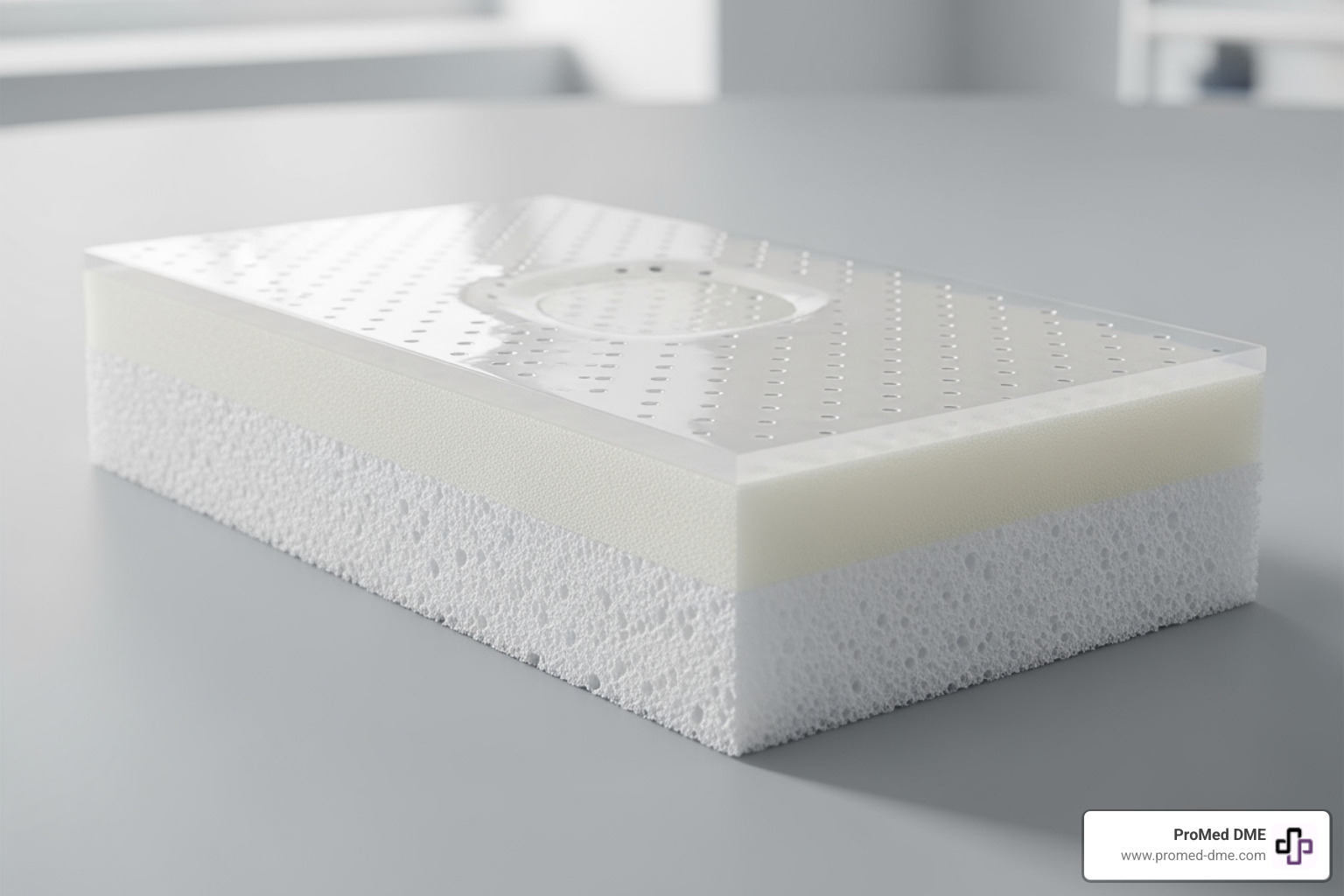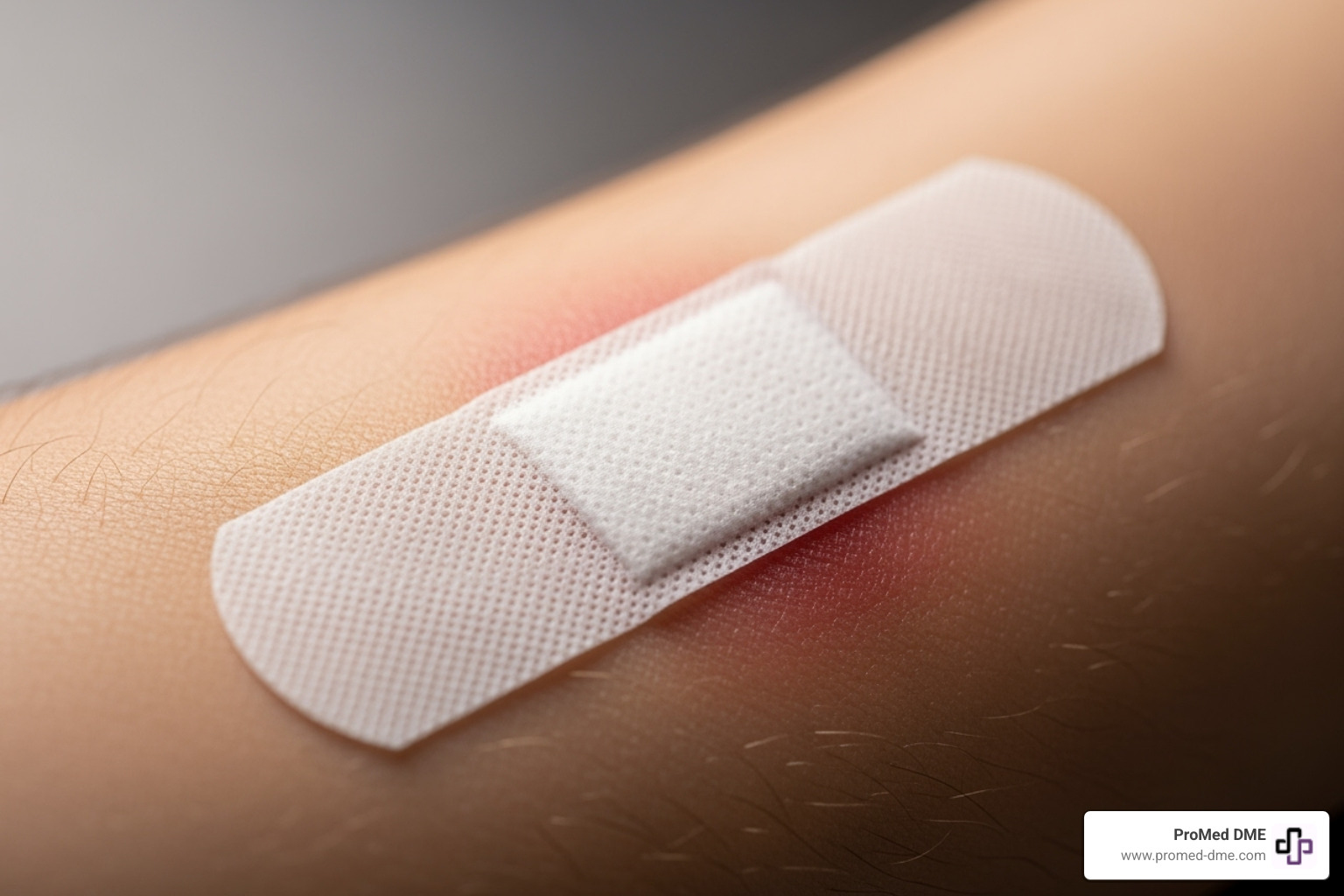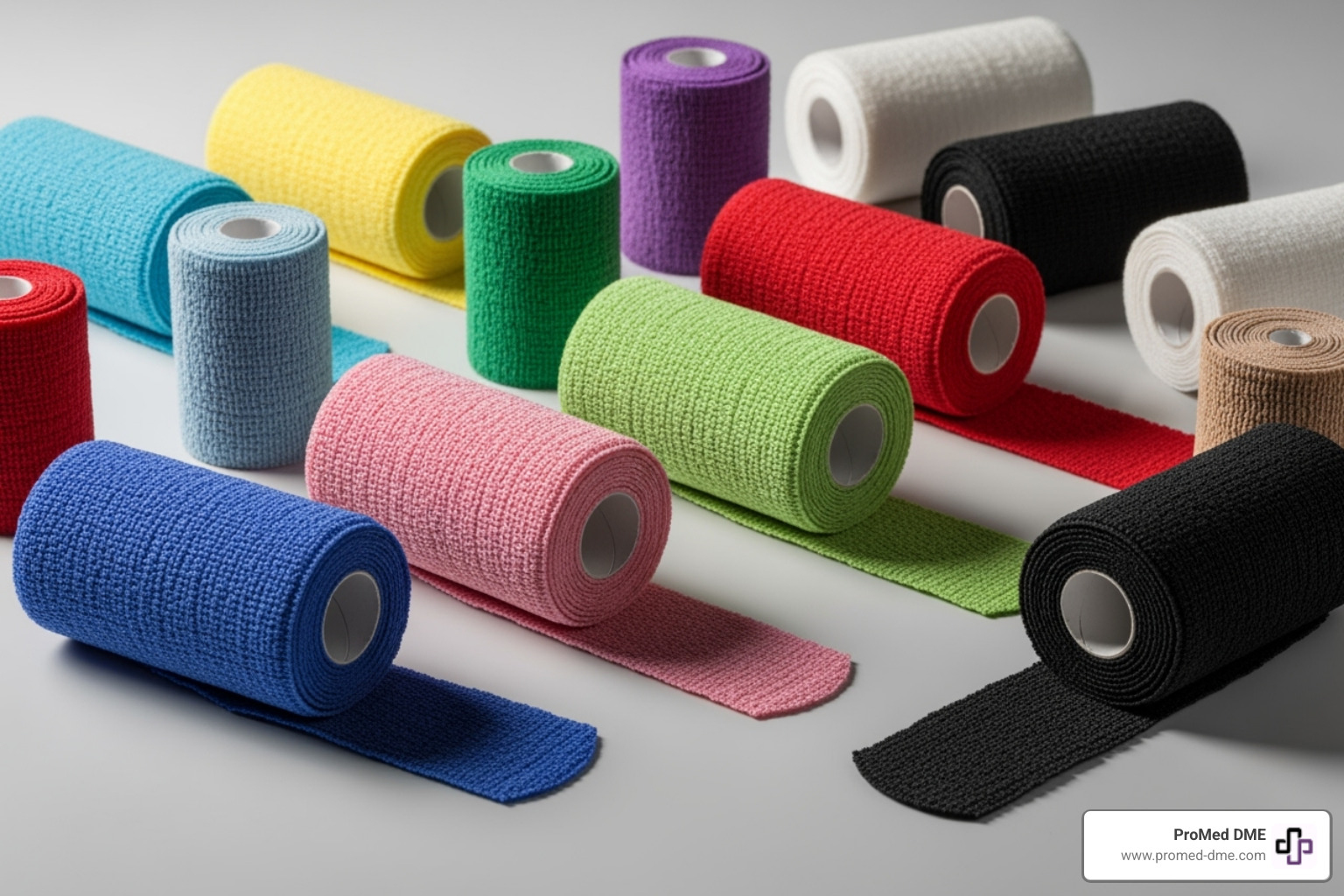Unsticking the Truth: Why Non-Adhesive Dressings Are a Game Changer
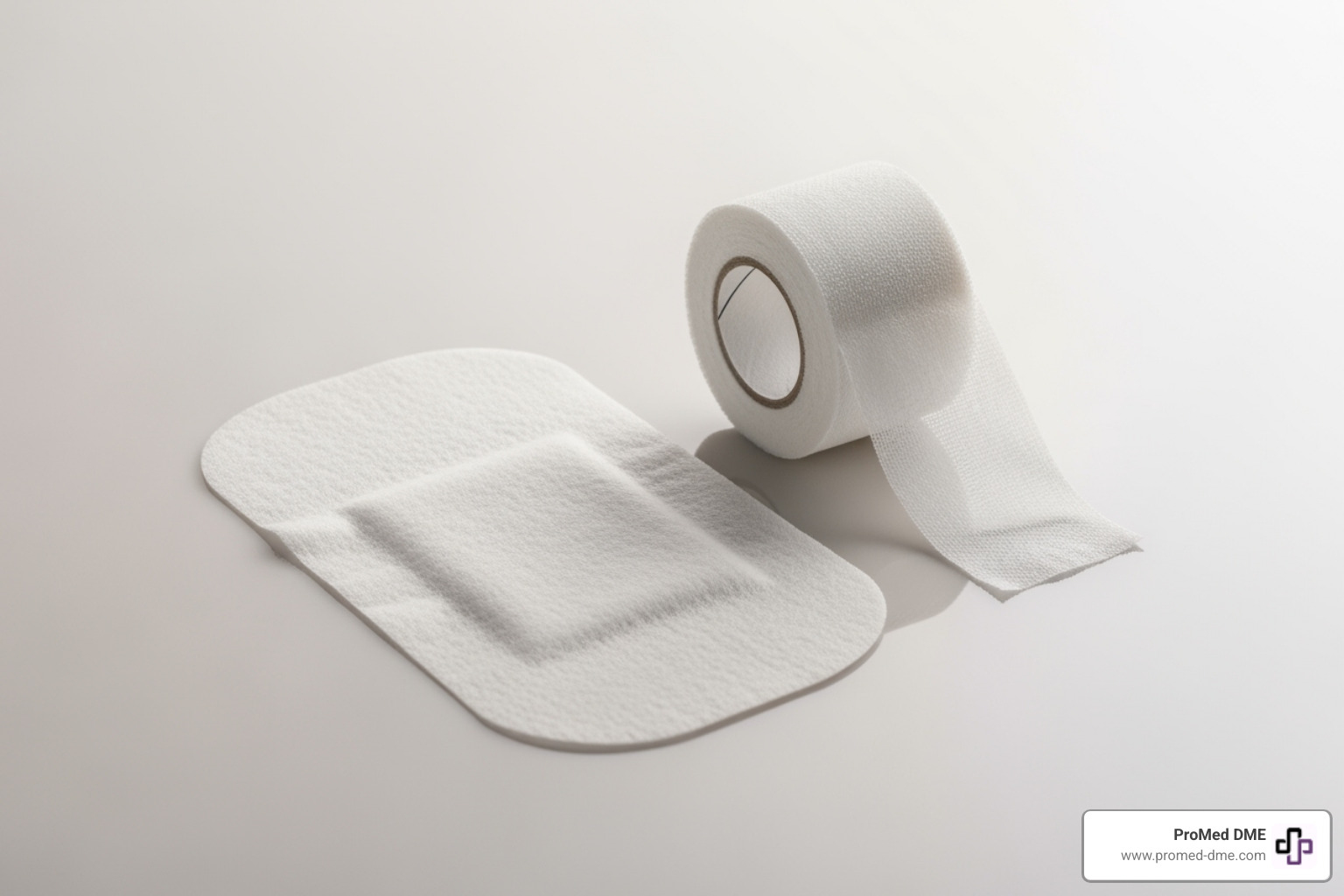
Why Non-Adhesive Dressings Matter for Comfortable Wound Care
Non adhesive dressing products are wound care materials without a sticky backing, requiring separate tape or wraps to stay in place. Unlike traditional bandages, they don't stick to the wound bed, making removal much less painful.
Quick Answer for Non-Adhesive Dressings:
- What they are: Wound contact layers without built-in adhesive
- How they work: Protect wounds while allowing pain-free removal
- Best for: Sensitive skin, frequent dressing changes, burns, surgical wounds
- Key benefit: Prevent tissue damage during dressing changes
- Application: Require secondary fixation (tape, wrap, or gauze)
If you've ever winced while peeling off a stuck bandage, you understand the problem non-adhesive dressings solve. Clinical studies show that non-stick pads are proven not to stick to wounds, eliminating that painful tugging.
This pain isn't just uncomfortable—it can slow healing. Damaging new tissue during a dressing change sets back the healing process, which is especially critical for people with diabetes, circulation issues, or fragile skin.
Non-adhesive dressings create a protective barrier that absorbs drainage while maintaining a moist healing environment. While they require securing with tape or a wrap, this small step can significantly improve comfort and healing speed.
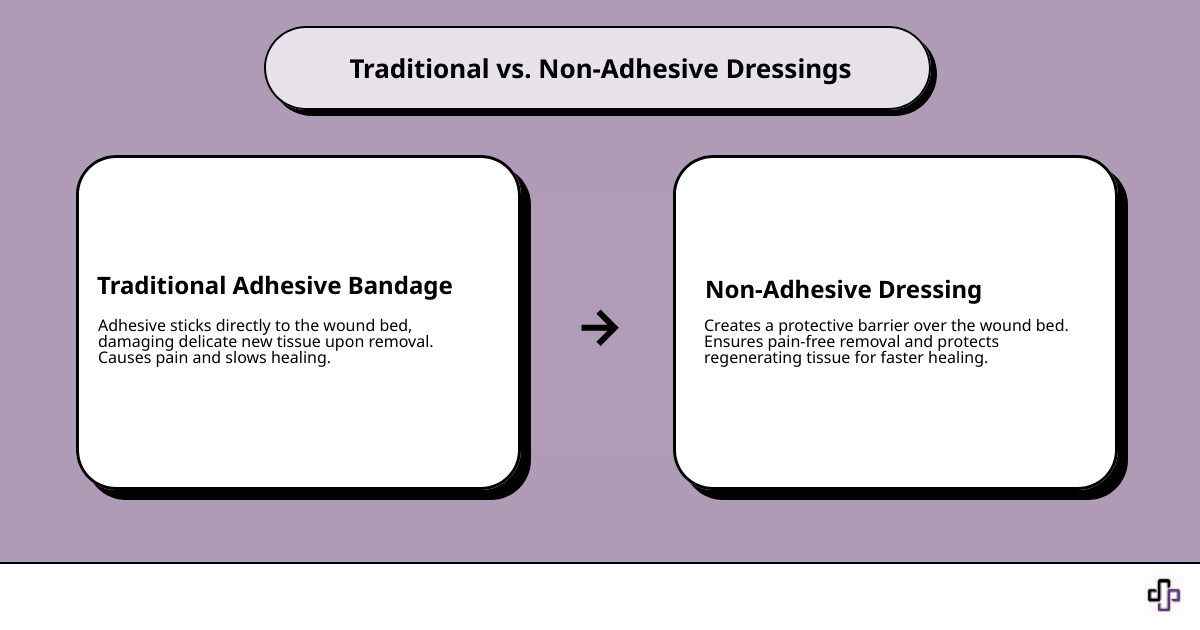
What Are Non-Adhesive Dressings?
A non adhesive dressing is a specialized wound contact layer that protects healing skin without sticking to it. The key difference from a standard bandage is its complete lack of a sticky backing. This means it must be secured with fixation tape, a medical wrap, or a secondary dressing.
Many of these dressings have a special polyethylene film coating that creates a barrier between the dressing and the wound. This design allows them to absorb drainage while ensuring atraumatic removal—meaning it won't hurt to take it off.
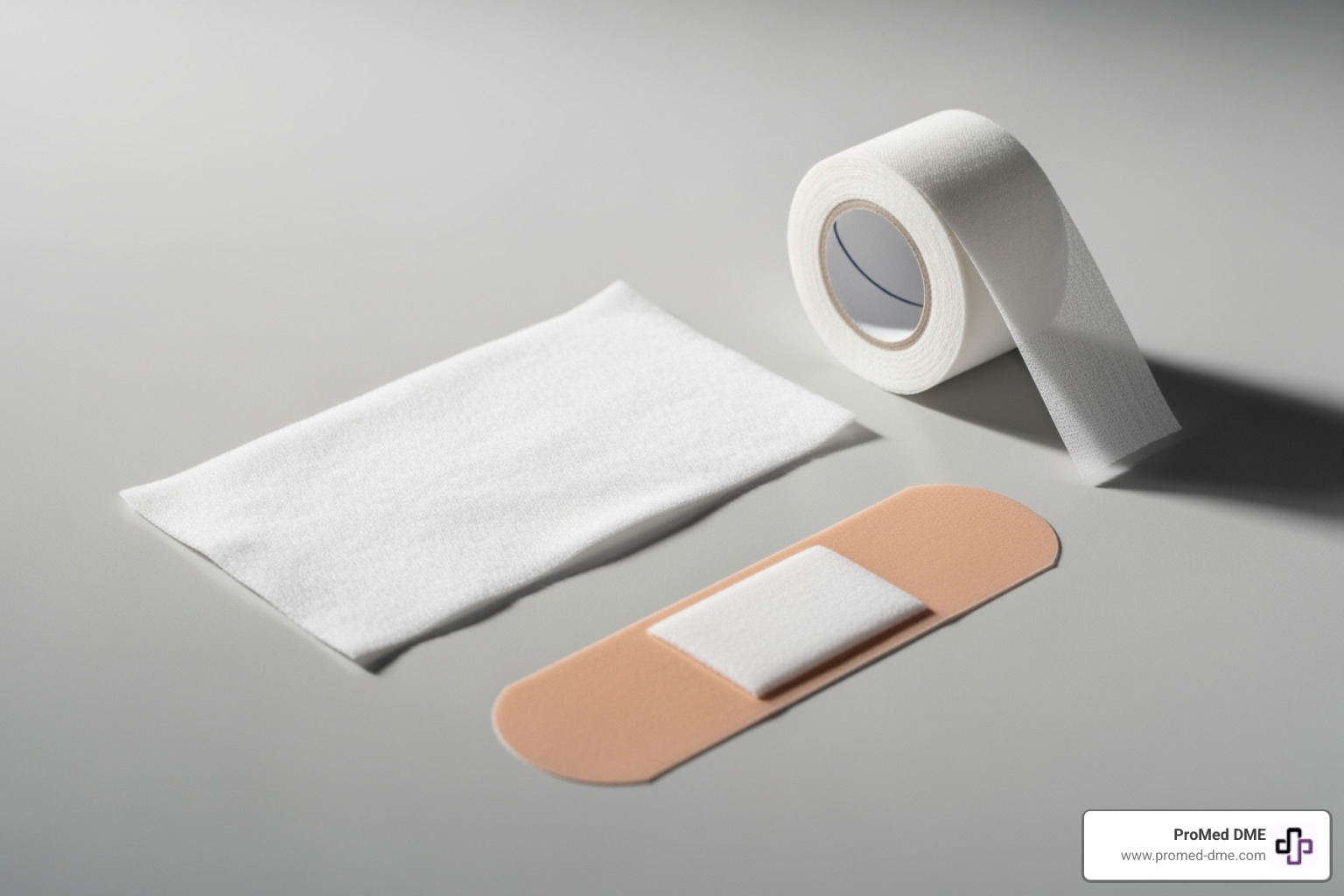
The Critical Difference: Non-Adhesive vs. Non-Stick
People often confuse "non-adhesive" and "non-stick," but they refer to different features.
When we say non-adhesive, we're talking about the backing. A non adhesive dressing has no sticky backing and requires fixation with tape or a wrap.
Non-adherent or non-stick, on the other hand, refers to the wound contact surface. This special layer prevents sticking to the wound bed, protecting delicate new cells.
Most quality non-adhesive dressings are designed to be both non-adhesive and non-stick for maximum patient comfort.
How They Compare to Gauze and Adhesive Bandages
Traditional gauze can stick to healing tissue, making removal painful. Adhesive bandages, while convenient, can irritate sensitive skin with their adhesive border.
Non adhesive dressings offer minimal adherence to wounds and very low pain on removal, making them ideal for fragile skin. While they require an extra step for fixation, the trade-off is reduced skin trauma and better suitability for sensitive skin.
They also excel at exudate management (wound fluid), absorbing drainage while maintaining a protective barrier. This gentle approach is especially beneficial for elderly patients, children, or anyone with delicate skin.
The Primary Benefits of a Gentler Approach
Non adhesive dressing products are designed for comfortable healing, which is essential for patients with sensitive skin or fragile skin, such as elderly patients and children in pediatric care.
The primary benefits are what these dressings don't do. They don't leave adhesive residue, cause allergic reactions from harsh adhesives, or cause pain during changes. This significant reduction in pain makes the healing process much more manageable.
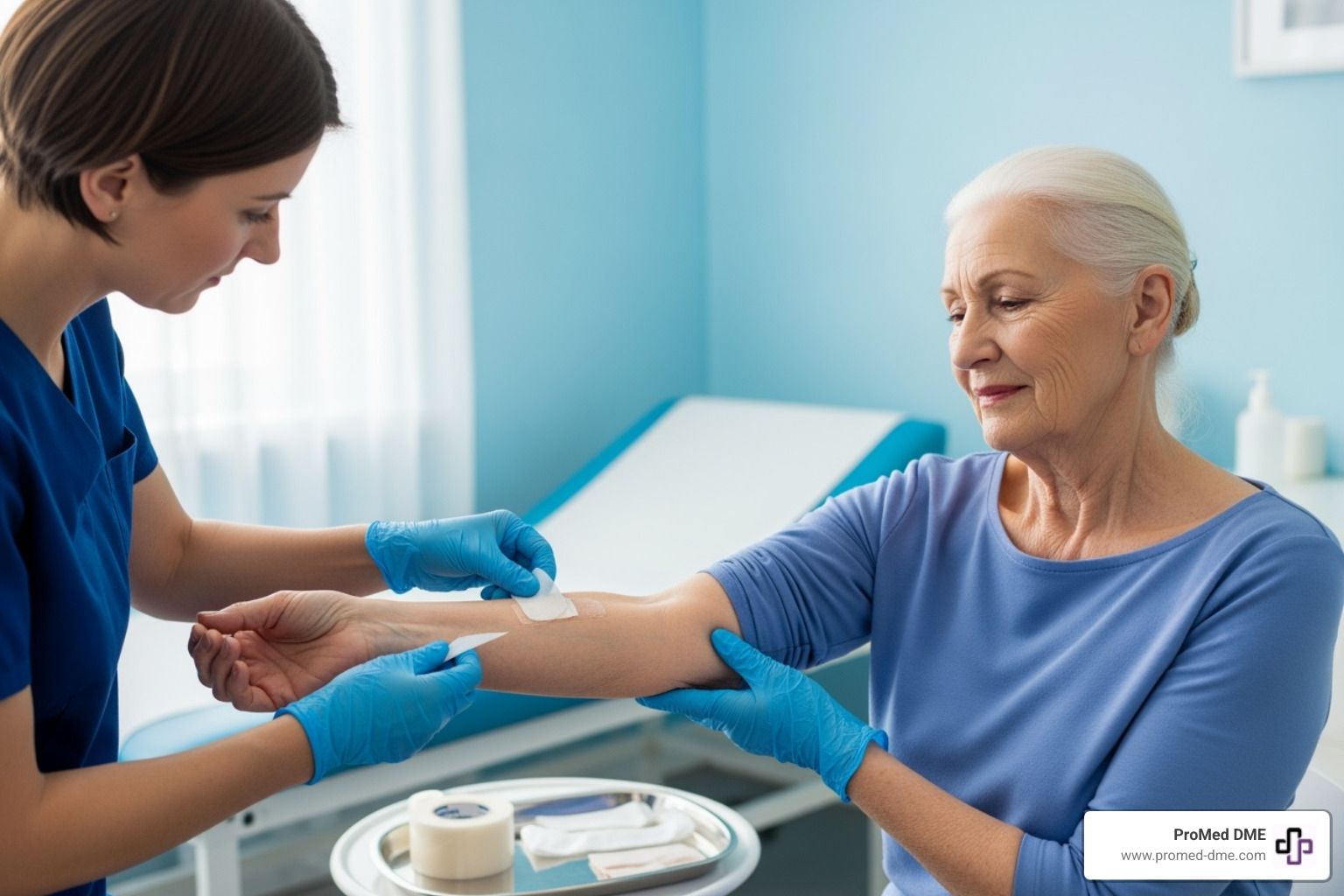
Protecting Regenerating Tissue for Faster Healing
Ripping off a stuck bandage can tear away new, delicate cells, delaying healing. A non adhesive dressing removes smoothly, which minimizes trauma to these new cells.
This gentle approach prevents disruption of the wound bed, allowing the body's repair process to continue without interruption. New cells can multiply and form healthy tissue, leading to less scarring and faster healing because the wound isn't being constantly re-injured.
Creating a Moist Wound Healing Environment
Modern wound science shows that a moist environment is best for healing, contrary to the old advice to "let it air out."
Non adhesive dressing products excel at exudate management, absorbing wound fluid while maintaining breathability. This balance prevents maceration (skin breakdown from too much moisture) while creating the ideal healing conditions. Scientific research on post-surgical wound care confirms that this moist approach speeds up the healing process and improves outcomes.
A moist environment allows cells to move easily, helps the body clean the wound, and promotes new tissue growth.
A Guide to the Different Types of Non-Adhesive Dressings
Choosing the right non adhesive dressing depends on the wound's specific needs. Different types offer unique material compositions, absorbency levels, and conformability to suit various wound types.
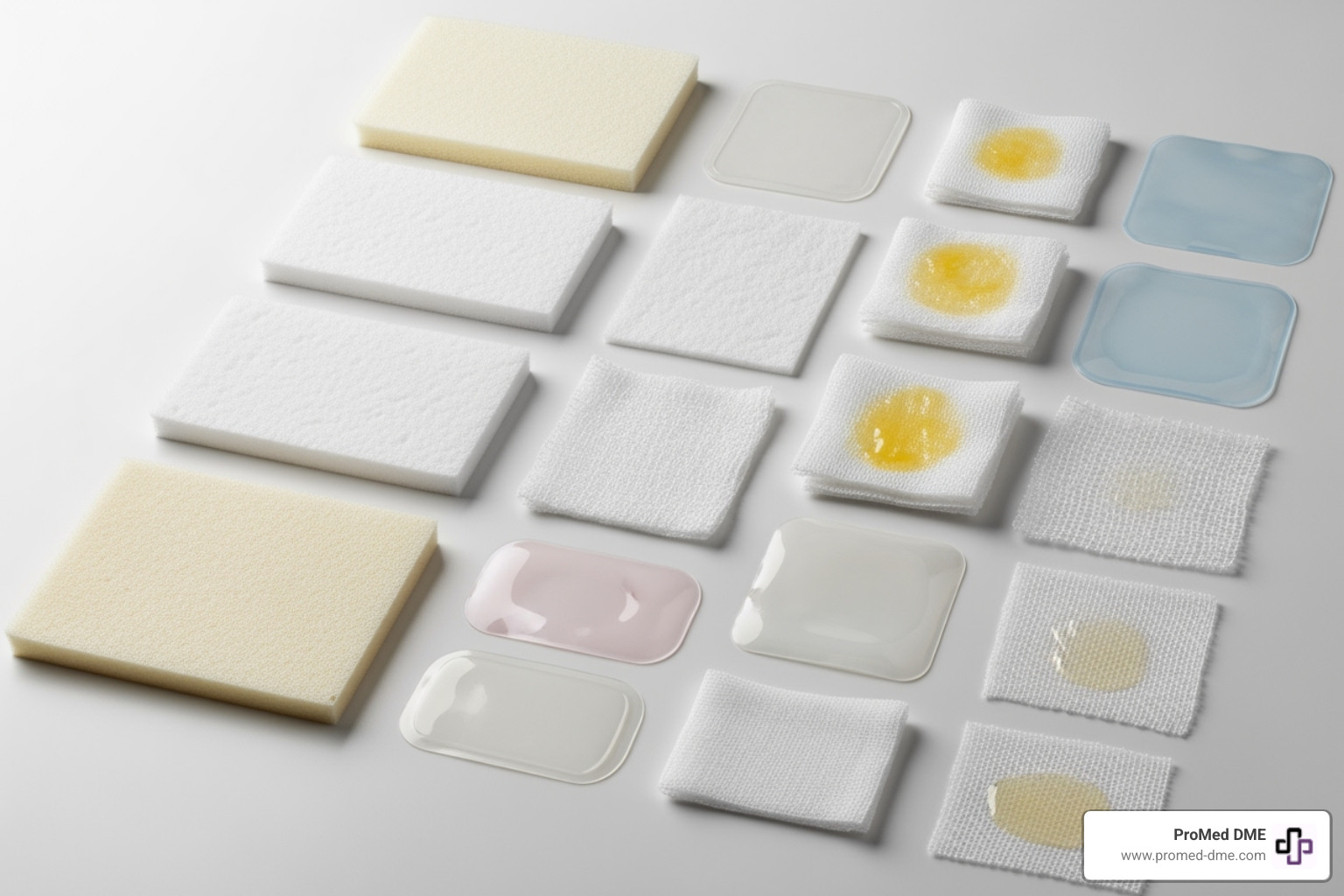
Foam Dressings
Made from polyurethane foam, these dressings are highly absorbent and ideal for moderate to heavy wound drainage. Their porous structure creates high absorption capacity while maintaining a moist healing environment. Foam dressings also provide excellent cushioning and protection, making them a great choice for exuding wounds in areas prone to bumps.
Silicone Contact Layers
Silicone contact layers feature an open-mesh design for maximum comfort and minimal trauma. They have a gentle adherence quality that helps them stay in place without sticking to the wound tissue. The mesh structure allows exudate transfer to a secondary absorbent dressing, keeping the wound drained and protected. Because silicone is non-adherent, removal minimizes pain.
Impregnated and Specialty Dressings
These dressings are improved for specific purposes.
- Petrolatum-impregnated dressings use fine-mesh gauze saturated with petrolatum. This prevents drying out and has a soothing effect while allowing drainage to pass through. They can be cut to fit any wound shape.
- Hydrogel options are another specialty type that helps maintain optimal hydration levels in wounds that need extra moisture, providing comfort for painful wounds.
The Role of Silver in a non adhesive dressing
Some non adhesive dressing products contain silver for its natural antimicrobial properties. Silver ions are released to reduce bioburden (harmful bacteria and fungi), making these dressings valuable for infected wounds or those at-risk of infection.
However, silver dressings are not for every wound and should be used under professional guidance. For clean, healthy wounds, a standard dressing is sufficient. At ProMed DME, our dedicated nursing staff can help determine if a silver-improved non adhesive dressing is right for your situation.
How to Choose and Use the Right Non-Adhesive Dressing
Choosing the right non adhesive dressing begins with a wound assessment. Consider the wound type, size, location, and especially the exudate level (the amount of fluid it produces). This will guide your choice of dressing and the necessary secondary dressing. A flexible, conformable dressing is needed for joints, and proper application is key to effectiveness.
Ideal Wound Types for a non adhesive dressing
Non-adhesive dressings are versatile and ideal when pain reduction and tissue protection are priorities.
- Burns: Especially first and second-degree, where skin is too delicate for adhesive removal.
- Skin tears: Common in elderly patients with fragile skin, these dressings prevent further damage.
- Lacerations and abrasions: A non adhesive dressing makes changes more comfortable, especially for children.
- Surgical incisions: Protects healing incisions with staples or sutures from disruption during dressing changes.
- Chronic wounds: For leg ulcers, pressure ulcers, and diabetic ulcers, these dressings prevent trauma to fragile surrounding skin over long healing periods.
- Donor sites and weeping eczema also benefit from a gentle, non-adherent barrier.
Key Features to Look For
When selecting a non adhesive dressing, consider these features:
- Absorption capacity: Match the dressing's absorbency to the wound's drainage. High-absorption foams are for heavy drainage, while impregnated gauze may suit lighter drainage.
- Flexibility: The dressing should be soft and conformable, especially over joints.
- Breathable backing: A semi-permeable backing allows moisture vapor to escape while keeping bacteria out, preventing skin from becoming waterlogged.
- Ease of use: The dressing should be easy to handle and cut to size if needed.
- Sterile packaging: Ensure each dressing is individually wrapped and sterile to prevent infection.
- Non-adherent surface: The wound-contact layer must be truly non-stick to ensure a comfortable, pain-free removal.
How do non-adhesive dressings prevent maceration and leakage?
Non adhesive dressing products prevent maceration (skin breakdown from excess moisture) and leakage through effective fluid management.
When a wound produces too much fluid (exudate) that sits on the skin, it can cause maceration. Non-adhesive dressings are designed to manage this moisture. For example, foam dressings act like sponges, pulling fluid away from your wound and locking it within their structure. Some advanced foam designs absorb fluid even under pressure.
While absorbing excess fluid, these dressings are also designed to be breathable. Many have outer layers that allow water vapor to escape while blocking bacteria. This maintains a healthy, moist healing environment without waterlogging the skin.
Other dressings, like mesh-like contact layers, allow fluid to pass through to a secondary absorbent pad. This prevents fluid from pooling on your wound surface, which is exactly what you want to avoid maceration.
The conformability factor is also key. When a dressing fits snugly against your skin, there are no gaps for fluid to leak. Finally, the need for a secondary dressing allows you to customize the absorbency level. You can pair the non-adhesive layer with a super-absorbent pad for heavy drainage or simple gauze for light drainage, creating a custom solution that prevents both maceration and leakage.
Frequently Asked Questions about Non-Adhesive Dressings
How do you keep a non-adhesive dressing in place?
Since a non adhesive dressing lacks a sticky backing, it requires fixation. Common methods include:
- Medical tape: Secure the dressing edges to healthy skin with paper, cloth, or waterproof tape.
- Self-adherent wraps: These wraps stick to themselves, not your skin, and are great for securing dressings on arms or legs.
- Secondary dressings: Larger absorbent pads, often with their own adhesive borders, can be placed over the non-adhesive layer.
- Conforming bandages: These are ideal for joints and curved areas.
For best results, use proper sizing: choose a dressing slightly larger than the wound to allow room for fixation. Our dedicated nurses are always happy to walk you through the best approach for your specific situation.
How often should the dressing be changed?
The frequency of dressing changes depends on several factors.
- Your wound's personality matters most. Wounds with heavy drainage (exudate) may need daily changes, while drier wounds might only need changes every few days.
- Manufacturer instructions: Follow the guidelines for your specific non adhesive dressing. Some advanced dressings can be worn for several days.
- Your healthcare provider's advice trumps everything else. Always follow the personalized schedule provided by your doctor or nurse.
Change the dressing immediately if you see leakage, notice an odor, or if it becomes loose or soiled.
Can non-adhesive dressings be used on infected wounds?
Yes, non adhesive dressing products are often recommended for infected wounds. Their gentle, pain-free removal is crucial when the surrounding skin is inflamed and sensitive. The excellent absorption capacity of many non-adhesive dressings helps manage the increased drainage common with infections.
Silver-infused non-adhesive dressings are particularly useful for infected wounds, as they have antimicrobial properties that help reduce the bacterial load. However, silver dressings should only be used under professional guidance.
Using a non adhesive dressing on an infected wound must be part of a comprehensive treatment plan from a healthcare provider, which may include wound cleaning and antibiotics. Consult with our nursing staff or your provider to choose the most appropriate dressing.
Conclusion
Non adhesive dressing products represent a core principle in modern healthcare: healing doesn't have to hurt. These gentle solutions protect your wound without sticking to it, which is critical for sensitive skin, frequent dressing changes, or slow-healing wounds. By eliminating the trauma of painful removal, wounds can heal faster and with less scarring.
We've seen how different types, from highly absorbent foam dressings to gentle silicone contact layers, serve unique needs by creating a moist healing environment while expertly managing fluid. While they require tape or a wrap, this extra step is a small price for the significant gains in comfort and healing speed.
At ProMed DME, we believe in gentle, effective wound care. Our dedicated nurse is always available to help you select the right product for your needs. With our free shipping and assistance with insurance coverage, getting the high-quality care you deserve has never been easier.
Choose the gentle approach of a non adhesive dressing for a more comfortable and effective recovery.
Related Resources & Articles
Stay informed with our informative blog posts.
Discover the ProMed Advantage
& Try Our Products
We offer free shipping and legendary customer service to ensure you receive the
best DME products for your needs.

